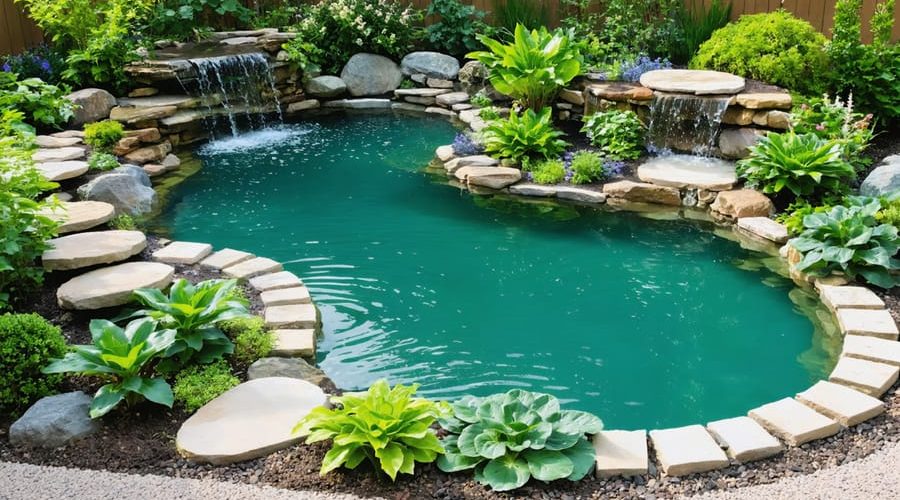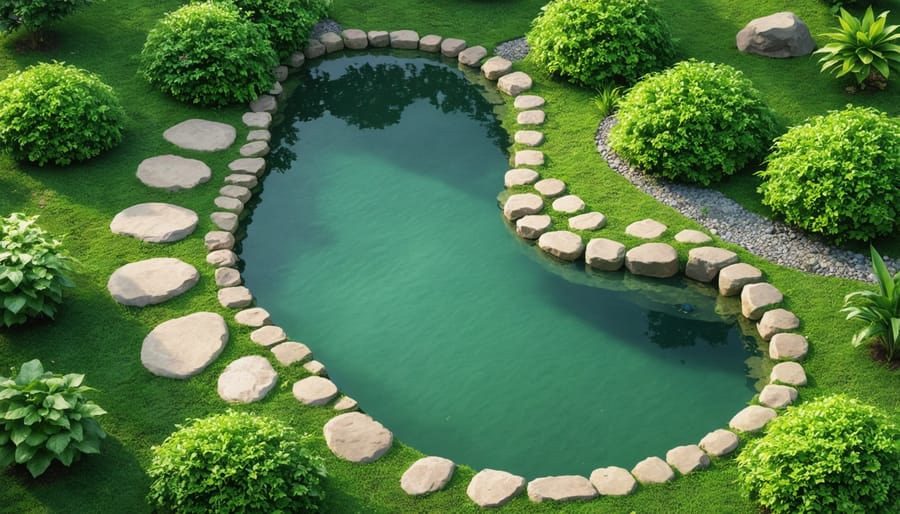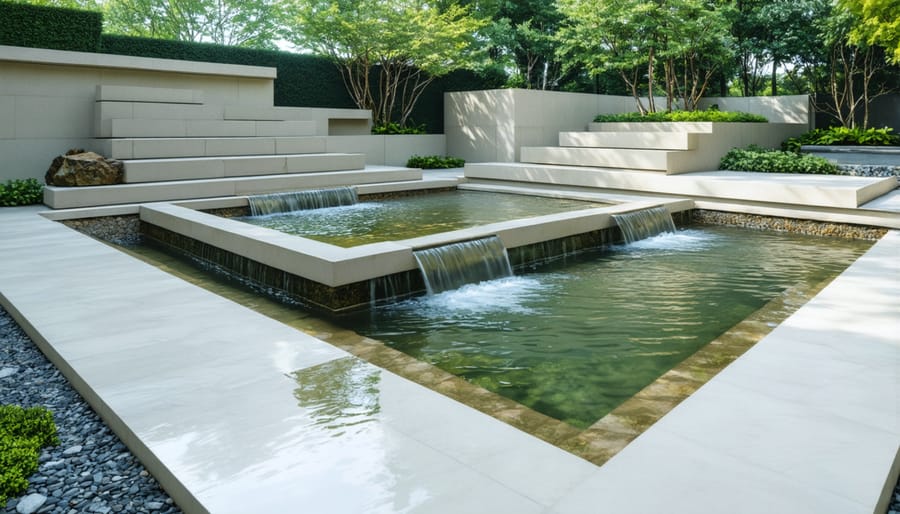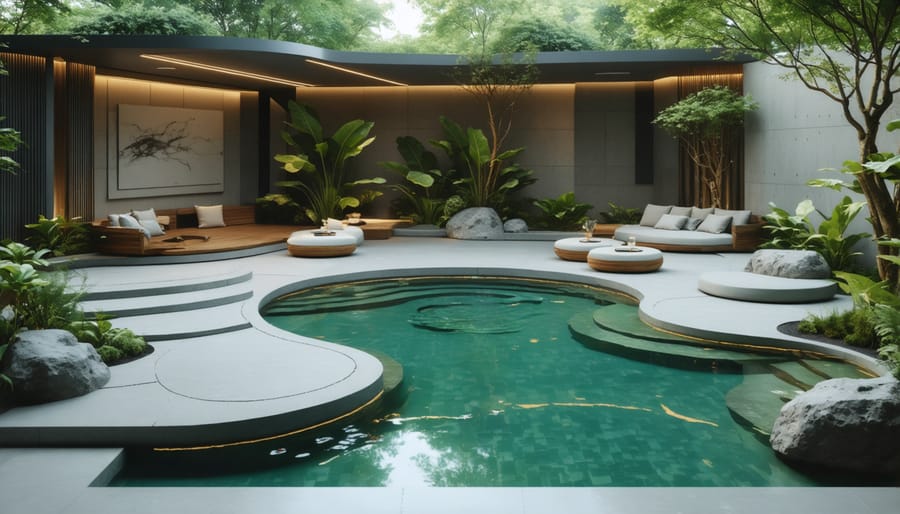
Transform Your Backyard With These Eye-Catching Pond Shapes
Transform your outdoor space into a tranquil oasis with eye-catching backyard pond ideas that blend seamlessly with your landscape. Create dramatic focal points using natural stone waterfalls cascading into free-form pools, or design sleek geometric ponds that complement modern architecture. Layer different water depths to accommodate various aquatic plants while providing safe zones for ornamental fish. Position your decorative pond where it can be viewed from multiple angles – perhaps visible from living areas or integrated with existing garden pathways.
The perfect pond transforms ordinary gardens into extraordinary retreats, combining the soothing sounds of moving water with stunning visual elements. Whether you’re drawn to naturalistic designs with curved edges and native plantings, or contemporary installations with clean lines and architectural features, a well-planned water feature adds value and character to any outdoor setting. Consider incorporating LED lighting, floating fountains, or stepped terraces to create dynamic day and night displays that captivate throughout the seasons.
Natural Pond Designs That Blend With Your Landscape
Kidney-Shaped Ponds
Kidney-shaped ponds are among the most popular and visually appealing designs in water gardening, offering a perfect balance between natural aesthetics and practical functionality. This organic shape mimics the curved edges found in nature, creating a more authentic look that seamlessly integrates with your existing landscape.
The curved design offers several practical advantages. The inward curve creates a natural viewing area where you can place seating or a small deck, allowing you to get closer to the water feature and enjoy your aquatic plants and fish from different angles. This design also provides excellent opportunities for creating varying depth zones, which is essential for supporting diverse pond life and maintaining healthy water circulation.
When planning a kidney-shaped pond, consider orienting the curve to complement your garden’s existing features. The concave section works wonderfully as a backdrop for waterfall features or rock arrangements, while the convex edges are perfect for softscaping with marginal plants and ground cover.
For the best results, aim to make the curves gentle and flowing rather than sharp or angular. A typical kidney-shaped pond should be roughly 1.5 times longer than it is wide, though you can adjust these proportions to suit your space. This shape is particularly effective in medium to large gardens but can be scaled down for smaller spaces while maintaining its natural appeal.

Free-Form Wildlife Ponds
Free-form wildlife ponds offer a natural and inviting approach to water gardening that seamlessly blends with your landscape while creating a haven for local wildlife. Unlike geometric designs, these irregular-shaped ponds mimic natural water features you might find in the wilderness, with curved edges, varying depths, and gentle slopes.
To create an effective wildlife pond, incorporate different zones within your design. Include shallow marshy areas where amphibians can lay eggs, deeper sections for fish to overwinter, and gently sloping banks that allow animals to enter and exit safely. These varying depths also create diverse habitats for different types of aquatic plants.
When planning your pond’s shape, think about sight lines from your favorite viewing spots, such as a patio or window. Use flowing curves that complement your existing landscape features, and consider adding small peninsulas or islands to create interest and provide safe havens for wildlife.
Natural materials like local stones and native plants help establish an authentic look. Position larger rocks and logs around the edges to create hiding spots for creatures like frogs and newts. Include a mix of marginal plants, floating vegetation, and submerged oxygenators to establish a balanced ecosystem.
Remember that wildlife ponds look best when they appear to have always been part of the landscape. Allow some areas to grow slightly wild, and don’t be too neat with the edges – nature rarely creates perfect lines!
Modern Geometric Pond Designs
Circular and Square Ponds
Circular and square ponds are timeless classics in water garden design, offering clean lines and structured beauty to any outdoor space. Circular ponds create a sense of harmony and natural flow, making them perfect focal points for gardens of any size. The symmetrical shape allows for easy viewing from all angles, and the continuous curve creates a peaceful, meditative atmosphere.
Square ponds, on the other hand, bring a modern, architectural element to your landscape. They work particularly well in contemporary garden designs and smaller spaces where maximizing corner areas is essential. The straight edges of square ponds also make it easier to install stone borders and integrate other geometric garden features.
When building either shape, proper planning is crucial. For circular ponds, use a rope attached to a center stake to mark your perfect circle. Square ponds require careful measuring and marking of right angles – remember to check your diagonals to ensure true square corners.
Both designs offer unique opportunities for features like fountains and waterfalls. Central fountains work beautifully in circular ponds, while square ponds excel with corner waterfalls or multiple fountain jets. Consider adding underwater lighting to highlight these geometric shapes after dark, creating stunning reflections that enhance your garden’s nighttime appeal.
For maintenance, both shapes are relatively straightforward to clean, though circular ponds tend to have better natural water circulation, while square ponds might need additional consideration for proper water flow in the corners.
Multi-Level Angular Designs
Multi-level angular designs bring a contemporary edge to your pond landscape while creating fascinating depth and visual interest. By incorporating different heights and geometric angles, you can transform a flat water feature into a dynamic masterpiece that catches the eye from every direction.
Start by planning at least two distinct levels, with the upper level cascading into the lower one. Consider creating a series of angular platforms using natural stone or modern concrete blocks. These steps can range from subtle 6-inch drops to dramatic 2-foot variations, each creating its own mini-waterfall effect.
The magic happens when you combine these levels with strategic angles. Instead of traditional curved edges, opt for bold 45-degree cuts or striking zigzag patterns. These sharp lines not only make a bold statement but also create perfect spots for pond lighting solutions that cast dramatic shadows after dark.
For added interest, incorporate angular planted sections between levels. These can house water-loving plants or serve as raised rock gardens. Try positioning larger stones at varying angles to echo your design’s geometric theme. Remember to maintain adequate water flow between levels – a slope of about 1 inch per foot ensures proper circulation while preventing stagnant areas.
Keep maintenance in mind by ensuring each level is accessible for cleaning and plant care. Adding small maintenance platforms or stepping stones at strategic points makes upkeep much easier while adding to the overall angular aesthetic.

Space-Saving Pond Shapes
Corner Pond Designs
Got an awkward corner in your yard that seems unusable? Transform it into a stunning focal point with a corner pond design! These space-saving water features are perfect for making the most of those often-overlooked angles in your landscape.
Corner ponds work particularly well against fences or walls, creating a natural transition between different areas of your garden. Consider a triangular design that fits snugly into the corner, or try a curved quarter-circle shape for a softer look. Adding stepped levels within your corner pond creates visual interest and provides perfect spots for placing potted water plants.
To maximize the impact, incorporate a small waterfall that cascades down the corner walls. This not only adds beautiful movement and sound but also helps with water circulation. Rock arrangements along the edges can help blend the pond naturally into your existing landscape while hiding liner edges.
For smaller spaces, even a compact 3×3 foot corner pond can make a significant impact. Add underwater lighting to create magical evening ambiance, and consider incorporating a bench nearby to create a peaceful retreat in what was once wasted space.

Narrow Water Features
Narrow water features are perfect for maximizing limited outdoor spaces while still creating a stunning water element in your garden. These linear designs can transform a plain wall, fence line, or narrow pathway into a captivating focal point. Consider installing a sleek channel-style pond that runs alongside your garden path, creating a peaceful ambiance with the gentle sound of flowing water. For tight spaces, a cascading wall fountain or a series of connected shallow basins can add vertical interest without consuming valuable ground space.
When designing narrow water features, proper small water garden filtration is essential to maintain crystal-clear water. Think about incorporating aquatic plants like rushes or narrow-growing water lilies that complement the linear design while helping to keep the water balanced. LED strip lighting along the edges can create magical evening effects, making your narrow water feature a 24-hour attraction.
For added interest, consider using different materials like polished stone, copper, or stainless steel to create contrast with surrounding landscaping. Remember to include easy access points for maintenance and ensure proper water circulation to prevent stagnation.
Practical Considerations for Shape Selection
Maintenance Access
When designing your pond, it’s crucial to consider how you’ll maintain your water feature in the long run. Simple geometric shapes like rectangles and circles typically offer the easiest access for cleaning and maintenance. These shapes allow you to reach all areas from the edges without awkward corners or hidden spots where debris can accumulate.
Natural, curved shapes can be beautiful but may create maintenance challenges if not properly planned. Consider including flat stones or stepping areas around irregular edges to make maintenance more manageable. For deeper ponds, incorporate a shallow shelf around the perimeter – this gives you a stable platform for cleaning and plant maintenance.
L-shaped or complex designs should include access points at strategic locations. Remember to leave enough space around the pond’s edges (at least 2-3 feet) for comfortable movement while performing maintenance tasks. If you’re installing a skimmer or filter system, position it where you can easily reach it for routine cleaning and filter changes.
Fish and Plant Requirements
When designing your pond’s shape, it’s crucial to consider the needs of your aquatic inhabitants. Fish require adequate swimming space, so avoid narrow channels or tight corners where they might feel trapped. A pond depth of at least 2-3 feet is ideal for most ornamental fish, providing them with cool zones during hot weather and protection from predators.
For water plants, create different depth zones within your pond. Edge plants thrive in shallow shelves of 2-4 inches, while deep-water plants like water lilies need platforms 12-24 inches below the surface. Including these varying depths in your design not only supports plant health but also creates natural filtration zones.
Consider incorporating gentle slopes rather than steep walls, as this mimics natural habitats and makes maintenance easier. A gradually sloping edge also creates a safety zone for wildlife and allows marginal plants to establish themselves naturally.
Remember that sunlight exposure affects both fish and plants. While most aquatic plants need 4-6 hours of direct sunlight daily, too much sun can cause algae problems. Plan your pond shape to include both sunny and shaded areas, perhaps using strategic curves to create natural shade zones.
Construction Challenges
When planning your decorative pond, each shape brings its own set of construction challenges. Circular ponds require careful attention to maintaining a perfect curve during excavation, and you’ll need to ensure your liner fits smoothly without creating unwanted folds. A helpful tip is to use a central stake and rope to mark your perfect circle before digging.
Irregular, natural-looking ponds can be trickier to construct because they require more artistic vision and careful planning. The key is to avoid obvious symmetry while ensuring all areas are accessible for maintenance. Pay special attention to the depth variations, as natural-looking ponds typically have different levels that need proper support.
Rectangle and square ponds may seem straightforward, but achieving crisp corners requires extra care. Consider using corner blocks or specialized pond corner pieces to maintain structural integrity. The excavation needs to be perfectly level to prevent water from pooling unevenly.
For elevated ponds, factor in the additional weight of water and necessary structural support. A cubic foot of water weighs about 62.4 pounds, so proper reinforcement is crucial. When building multi-level ponds, ensure each tier is completely level and properly sealed to prevent leaks between sections.
Remember to plan for essential equipment like filters and pumps during the initial design phase, as these components need to be seamlessly integrated into your chosen shape.
Creating your own decorative pond is an exciting journey that can transform your outdoor space into a peaceful sanctuary. As we’ve explored throughout this guide, there are countless possibilities for designing a pond that perfectly matches your style and space requirements. Whether you’re drawn to the natural charm of a wildlife pond, the elegant symmetry of a formal design, or the contemporary appeal of a modern water feature, the key is to choose a design that resonates with your vision while considering practical aspects like maintenance and local climate.
Remember that successful pond creation is all about careful planning, from selecting the right location to choosing appropriate materials and plants. Don’t be afraid to start small – you can always expand your water feature as you gain confidence and experience. Consider incorporating elements like waterfalls, stepping stones, or creative lighting to add extra dimensions to your design.
Most importantly, enjoy the process! Building a decorative pond is more than just a landscaping project – it’s creating a living ecosystem that will bring joy and tranquility to your outdoor space for years to come. With the ideas and guidelines we’ve shared, you’re well-equipped to begin your pond-building adventure. Take your time, plan carefully, and soon you’ll be enjoying the soothing sounds of running water and the beauty of your very own backyard oasis.
